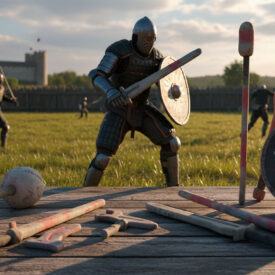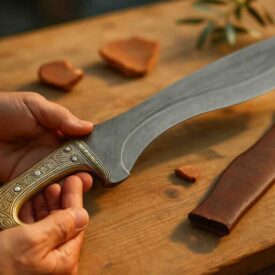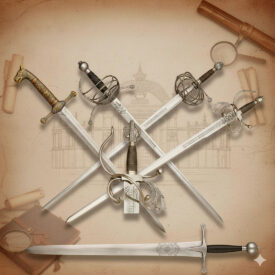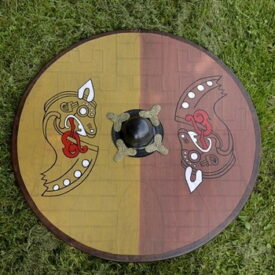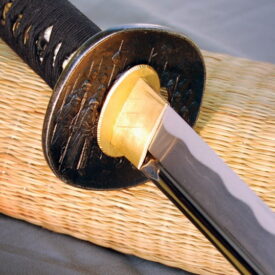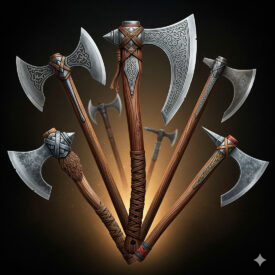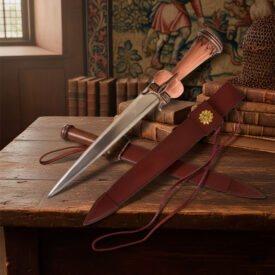Which weapon trembled in the hand of the Iberian warrior as the silence broke before the clash? The falcata: a curved blade forged for devastating cuts and also carved as a status symbol. In this article you’ll discover its origin, its unique design, how it was made, its role in war and why it still fascinates military history enthusiasts.
The history of the falcata through time
Before getting into technical details, place the falcata in time: its shape derives from Mediterranean traditions but culminates as an emblematic weapon on the Iberian Peninsula between the 5th and 1st centuries BC.
| Period | Event |
|---|---|
| I. Origin and Mediterranean prototypes | |
| 10th century BC | Tradition of weapons with an asymmetrical curved blade along the Balkan coasts of the Adriatic, distant precursors of the falcata. |
| 8th–5th centuries BC | Development and spread in the Balkan regions of the Adriatic of asymmetrical curved swords (prototypes that would give rise to the machaira/kopis). |
| From the 7th century BC | These curved swords spread to Greece and the Italian Peninsula adopting forms such as the machaira or kopis. |
| Route to Iberia | The Mediterranean prototype reached the Iberian Peninsula via the Italic world. |
| II. Adoption and development on the Iberian Peninsula | |
| Late 6th century BC – early 5th century BC | Formative phase on the Peninsula: modification of the Italic/Mediterranean prototype until the Iberian falcata was configured. |
| 5th century BC | Documented appearance of the falcata on the Iberian Peninsula and in iconography, such as the sculptural ensemble of Porcuna (Jaén). |
| III. Full phase and peak use | |
| 4th–3rd centuries BC | The falcata becomes widespread, appears in burial assemblages and shows intense production and use in the southeastern peninsula. |
| 4th century BC – last third of the 3rd century BC | Full phase: the falcata consolidates as a characteristic weapon of Iberian warriors. |
| IV. Decline and end of use | |
| Late 3rd century BC | Its presence diminishes; still used by Iberian mercenaries in conflicts such as the Second Punic War. |
| From the 1st century BC | Clearly less frequent, coinciding with Romanization and the adoption of other types of armament. |
| V. Nomenclature and modern reception | |
| 19th century | The modern term “falcata” becomes established to describe this curved form. |
| 20th–21st centuries | Academic and popular interest: study of its metallurgy, experimental reconstructions and presence in historical reenactment. |
What is the falcata? A journey to the heart of the blade
The falcata is a short iron (sometimes steel) sword with an asymmetrical, curved blade that concentrates weight toward the tip, giving each cut the force of an axe. Its length ranged around 45–55 cm, designed for close combat and to combine powerful cuts with precise thrusts.
Origin and influences: a Mediterranean design that becomes Iberian
Its shape did not appear out of nowhere. Curved weapons like the kopis and the machaira from the Greek and Balkan worlds share a common root with the falcata. Contact between peoples, trade and mercenaries explain how this prototype arrived and transformed on the Peninsula.
Although historically associated with Iberian identity, the falcata is part of a family of Mediterranean weapons. Its hilt and decorative details mark the cultural and functional differences between variants.
Design and functionality: the science of cutting
The silhouette of the falcata — concave near the handle and convex toward the point — concentrates mass on the distal half of the blade. That makes the weapon a perfect cutting tool: each strike generates great inertia and penetration power.
Some blades have a secondary edge on the upper part, which gives versatility for thrusting when the fight demands it. The grooves and channels seen on certain examples serve to lighten the weight without losing stiffness.
Comparative table of variants and characteristics
| Type | Blade length (approx.) | Period | Tactical use |
|---|---|---|---|
| Hispaniensis | 60–68 cm | 3rd–1st centuries BC | Versatile: powerful cuts and thrusts in tight formations. |
| Short falcata | 45–55 cm | 5th–3rd centuries BC | Close combat, heavy blows and use with a small shield. |
- Hispaniensis
-
- Blade length: 60–68 cm (approx.)
- Period: 3rd–1st centuries BC
- Tactical use: Versatile: powerful cuts and thrusts in tight formations.
Hilt and grip: ergonomics with meaning
The hilt, often made of wood or bone over a metal core, fits the hand like a glove. Terminations in the shape of a horse’s head or a bird are not just ornamental: they strengthen protection and convey symbolism of power and protection.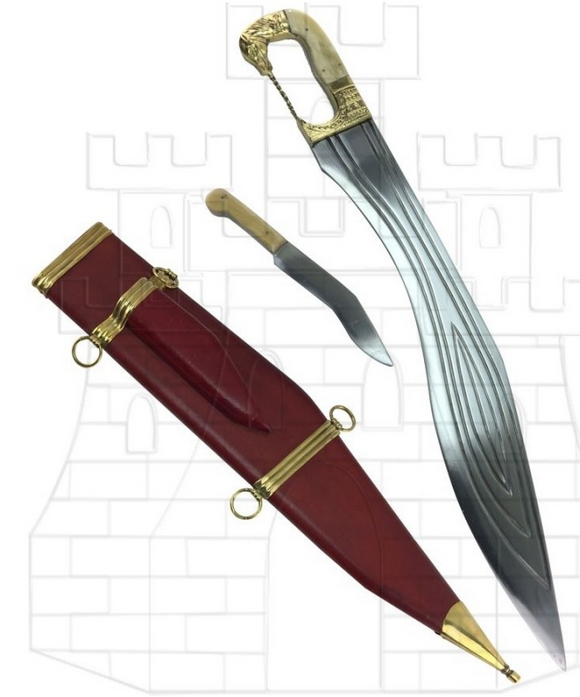
Manufacture: three plates and ancestral knowledge
The usual technique consisted of joining three iron plates, with a wider central one that served as the core and extended toward the hilt. Assembling these pieces hot and tempering them required precision: a good falcata had to flex and recover its shape to prove its temper.
Controlled oxidation processes and iron treatments, together with decorative damascening on wealthy examples, show remarkable metallurgical mastery for the period.

The Iberian warrior and his falcata
The falcata was a weapon associated with elite warriors. It was not universal across all territories, but where it appeared it became a symbol of status and effectiveness. The combination of falcata and shield — caetra or oblong shield — allowed mobile and aggressive fighting, with quick attacks to break enemy formations.
In practice, the Iberians preferred light armor that did not limit the mobility needed to take advantage of the blade’s power.
Busting myths
- It was not exclusive to Iberia: Variants of curved swords existed in the Mediterranean and the Italic world.
- The Romans knew these blades: The impact of the falcata in Rome was real but nuanced; what impressed was the quality of the metal and combat effectiveness.
- Its image in popular culture: Series and films have magnified its presence, sometimes placing it where no archaeological finds exist.
Resurrection and replicas
Today replicas allow the study of the handling and ergonomics of the falcata. historical fencing experiments demonstrate its effectiveness in downward cuts and short thrusts when the blade allows.
Answering your questions about the Iberian falcata
What was the primary use of the falcata in combat?
The primary use of the falcata in combat was for hand-to-hand engagement, where its curved, asymmetrical design was exploited to deliver clean, devastating cuts as well as effective thrusts. It was especially effective when combining cutting and stabbing techniques, acting powerfully against shields and armor in close engagements, and also adapting well to use with a shield. In essence, it was a predominant offensive weapon for infantry in close, direct combat.
What differences exist between the falcata and other ancient swords?
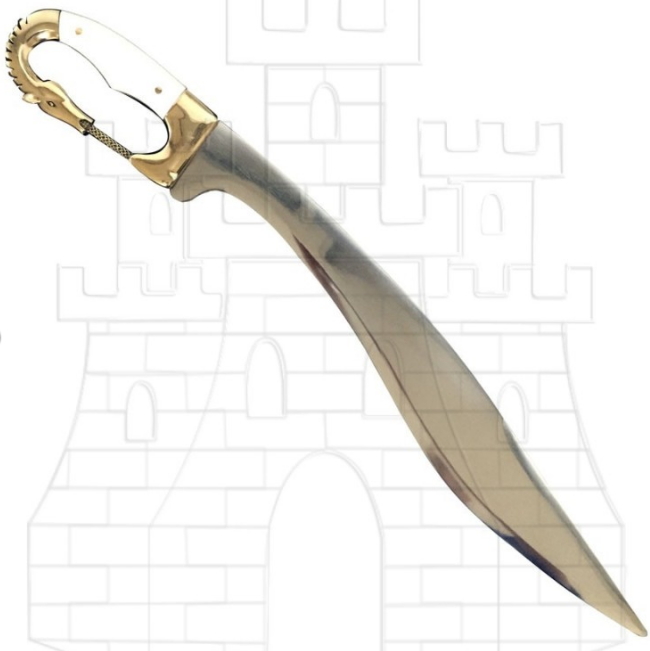 The main differences between the falcata and other ancient swords lie in its unique design and functionality:
The main differences between the falcata and other ancient swords lie in its unique design and functionality:
- Curved blade that widens toward the tip, single-edged, combining the power of an axe with the precision of a sword. This makes it particularly effective in heavy downward strikes suited to split shields or armor, whereas most ancient swords had straight blades or sabers with more uniform curves.
- Center of gravity shifted toward the middle of the blade, which maximizes cutting power without unbalancing the weapon, unlike straight swords that typically have a different balance more suited to thrusting.
- Characteristic hilt offset and shaped like a hook or horse head, which embraces the hand and often features a semicircular guard for protection, not common in other classical ancient swords like the Roman gladius or Celtic sabers.
- The falcata functioned as a hybrid between sword and axe, allowing very powerful cutting blows, while other swords could be more specialized in thrusting (like the gladius) or long cuts (like the saber).
- Its use was associated with Iberian warriors and it was a status symbol, highlighted by artistic decoration in silver, gold or shells, a feature less common in other more utilitarian ancient swords.
In summary, the falcata is a curved sword, heavy toward the tip, designed for powerful cutting blows and combining sword and axe characteristics, clearly differing from straight swords or less robust sabers with different balances and hilt styles.
How did the falcata influence Iberian war tactics?
 The falcata significantly influenced Iberian war tactics by favoring aggressive, agile close combat centered on deep, powerful cuts with a light, maneuverable weapon. Its curved design and wide blade enabled devastating attacks, which combined with shield use for defense and high battlefield mobility. This led Iberian warriors to wear little armor to maintain the agility needed for rapid maneuvers, ambushes and surprise attacks, taking advantage of the falcata’s offensive power in close, dynamic fights. Additionally, this sword contributed to tactics of quick strikes and precise hits aimed at breaking enemy formations and creating chaos, a style distinct from the use of heavier or longer weapons in other cultures of the time.
The falcata significantly influenced Iberian war tactics by favoring aggressive, agile close combat centered on deep, powerful cuts with a light, maneuverable weapon. Its curved design and wide blade enabled devastating attacks, which combined with shield use for defense and high battlefield mobility. This led Iberian warriors to wear little armor to maintain the agility needed for rapid maneuvers, ambushes and surprise attacks, taking advantage of the falcata’s offensive power in close, dynamic fights. Additionally, this sword contributed to tactics of quick strikes and precise hits aimed at breaking enemy formations and creating chaos, a style distinct from the use of heavier or longer weapons in other cultures of the time.
What materials were used to make the falcata’s hilt?
Falcata hilts were made with a metal core formed by the extension of a thin central iron plate that served as the spine, and were covered with scales of wood or bone. In some higher-quality examples, the scales could be partially covered with decorative metal pieces (damascening). The hilt had protective shapes, often representing horse heads or birds of prey, and featured rivets that simulated the eyes of these animals. This structure protected the hand and provided a good grip on the weapon. Thus, the main materials for the hilt were iron, wood and bone, with occasional decorative metal details.
What symbolism did the falcata have in Iberian culture?
The falcata in Iberian culture had a deep symbolism as a weapon of status, valor and social belonging. It was not just an instrument of war, but a distinctive symbol of the warrior aristocracy and power, as carrying it indicated high rank and an experienced warrior.
Furthermore, the falcata was a personalized object, made to measure for its owner, and in some cases accompanied the warrior into death, being buried with him or rendered unusable, which reinforced its symbolic and almost sacred character. The decoration of some falcatas included zoomorphic motifs and apotropaic symbols that alluded to divine protection or symbolic forces, consolidating its ritual and social value.
The falcata represented the identity and distinction of the Iberian warrior class, its value in combat and its connection to beliefs and symbols of power in Iberian society.
A legacy that invites reflection
The falcata is a piece where engineering, art and warrior life converge. Its design responds to practical needs in combat and to the will to express identity and rank. Understanding it is understanding a decisive part of the military history of the Peninsula.

